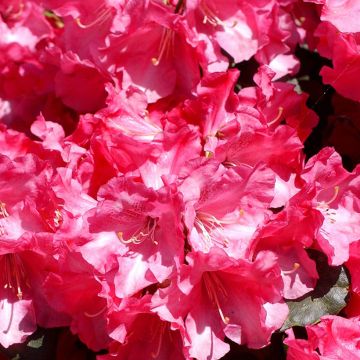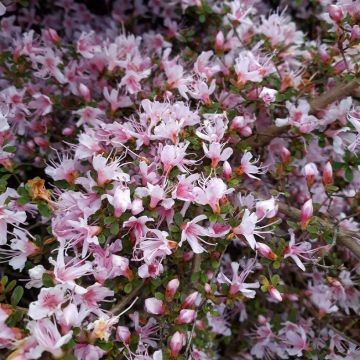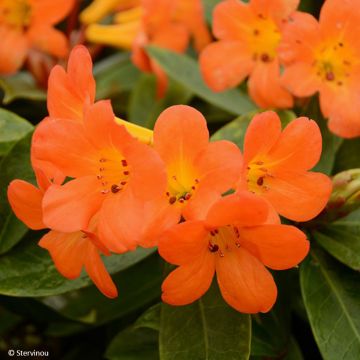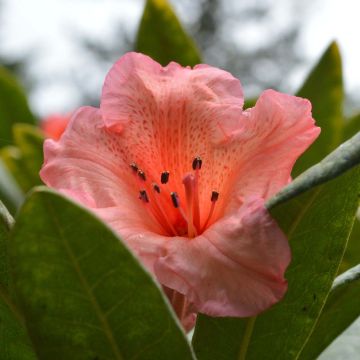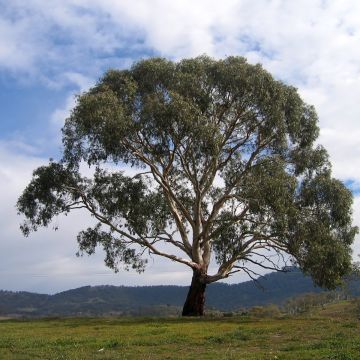

Rhododendron vireya Aertrycke - Tropical Rhododendron
Rhododendron vireya Aertrycke - Tropical Rhododendron
Rhododendron Aertrycke
Tropical Rhododendron
Why not try an alternative variety in stock?
View all →This plant carries a 24 months recovery warranty
More information
We guarantee the quality of our plants for a full growing cycle, and will replace at our expense any plant that fails to recover under normal climatic and planting conditions.
Does this plant fit my garden?
Set up your Plantfit profile →
Description
Rhododendron 'Aertrycke' is a tropical variety with a fairly compact habit, which is very interesting due to its long flowering period. This evergreen shrub is adorned with beautiful dark green foliage with a satin-like surface, which contrasts particularly well with its light-coloured flowers. The clusters of single, tubular flowers with trumpet-shaped ends are a pale yellow mixed with salmon pink. This not very hardy, exotic Rhododendron should be grown in a pot with acidic soil, in a semi-shaded location, and brought indoors to protect it from frost in winter.
As a member of the Ericaceae family, which includes many garden favorites such as Kalmia or Mountain Laurel, Rhododendron is a very important group, with around 850 species, classified in botanical taxonomy into sections and subsections. Mainly known through the hardy species that adorn our gardens, Rhododendron is also well established in tropical regions. The Vireya section (named after a French pharmacist, Julien-Joseph Virey, 1775-1846) includes no less than 300 tropical species, often epiphytic, growing on trees like many orchids, while others are terrestrial, growing in the ground. Some of these species have been crossed with each other to create horticultural varieties. 'Aertrycke' is one of them, this semi-epiphytic variety forms a relatively compact bush, less than 1 metre in all directions, with relatively slow growth. Its evergreen foliage is composed of rather small leaves, 3 to 6 cm long, elliptical in shape, and dark green, with a slightly shiny surface. Its vegetation is quite dense, and its dark colour highlights the bright flowering. Gathered in clusters of 5 to 10 at the end of the branches, the flowers, carried by floral peduncles 2 to 3 cm long, have a trumpet-like shape. In the typical fashion of the Ericaceae family, they are gamopetalous, meaning "with fused petals". The base of the flower is therefore tubular, gradually widening to finally open widely, with the petals no longer fused at the tip. These rounded petals are a light yellow enhanced by a salmon pink throat, which is very attractive. A cluster of stamens emerges from the center of the corolla, displaying brown anthers that add a delicate punctuation. In tropical climates, Rhododendron vireya tend to bloom throughout the year, with a slightly more intense flowering during what corresponds to our spring and autumn. Aertrycke will therefore offer a long spring flowering, possibly with a second flush in autumn, especially if you take care to regularly remove faded flowers to prevent the plant from becoming exhausted.
Rhododendron 'Aertrycke' will be difficult to grow outdoors due to its tropical origin, although it can tolerate light frosts of around -3°C to -4°C. Enthusiasts in mild coastal areas can try growing it by installing a misting system to combat dry air. Such a system will also allow you to grow the magnificent Dicksonia antartica tree fern alongside it, which also appreciates mildness and humidity, and whose highly divided fronds are borne on a dark brown trunk.
Elsewhere, you can grow your Rhododendron in a pot, which has the advantage of allowing you to choose an acidic potting soil that is well-suited to its needs, instead of relying on the soil in your garden, and enable you to bring it indoors when temperatures drop below 8-10°C. During the growing season, you can place the pot on a terrace in a semi-shaded spot, but the plant will thrive better under the light shade of other plants, which will help maintain a certain level of humidity in the air through their transpiration. To create an exotic scene, plant the Giant Horsetail (Equisetum camtschatcense) in another pot, with its unique architectural appearance, featuring long green stems with black rings. When grown in a pot, there is no risk of it becoming invasive in the garden.
Report an error about the product description
Plant habit
Flowering
Foliage
Botanical data
Rhododendron
Aertrycke
Ericaceae
Tropical Rhododendron
Cultivar or hybrid
Other Small Rhododendron
View all →Planting and care
Rhododendron 'Aertrycke' is a tropical variety that can only tolerate brief and light frosts, around -4°C. It should be grown in a pot to be protected from frost during winter. Plant it in a pot with a diameter of about thirty centimetres to start with, and after a few years, repot it in a slightly larger container. Use an acidic planting soil (pH 5 to 6) that is well-draining, and consider adding a layer of non-limestone gravel at the bottom. Choose a partially shaded spot, under plants that can maintain a certain level of air humidity through their evapotranspiration. Avoid windy and drying locations, and occasionally mist around the plant during hot periods. Water regularly to prevent the soil from drying out. Remove faded flowers as they appear to prolong the flowering period. Although the plant can tolerate light frosts, it is preferable to bring it indoors before winter to protect it. Watering should be reduced during this time, allowing the substrate to completely dry out between two waterings.
Planting period
Intended location
Care
This item has not been reviewed yet - be the first to leave a review about it.
Similar products
Haven't found what you were looking for?
Hardiness is the lowest winter temperature a plant can endure without suffering serious damage or even dying. However, hardiness is affected by location (a sheltered area, such as a patio), protection (winter cover) and soil type (hardiness is improved by well-drained soil).

Photo Sharing Terms & Conditions
In order to encourage gardeners to interact and share their experiences, Promesse de fleurs offers various media enabling content to be uploaded onto its Site - in particular via the ‘Photo sharing’ module.
The User agrees to refrain from:
- Posting any content that is illegal, prejudicial, insulting, racist, inciteful to hatred, revisionist, contrary to public decency, that infringes on privacy or on the privacy rights of third parties, in particular the publicity rights of persons and goods, intellectual property rights, or the right to privacy.
- Submitting content on behalf of a third party;
- Impersonate the identity of a third party and/or publish any personal information about a third party;
In general, the User undertakes to refrain from any unethical behaviour.
All Content (in particular text, comments, files, images, photos, videos, creative works, etc.), which may be subject to property or intellectual property rights, image or other private rights, shall remain the property of the User, subject to the limited rights granted by the terms of the licence granted by Promesse de fleurs as stated below. Users are at liberty to publish or not to publish such Content on the Site, notably via the ‘Photo Sharing’ facility, and accept that this Content shall be made public and freely accessible, notably on the Internet.
Users further acknowledge, undertake to have ,and guarantee that they hold all necessary rights and permissions to publish such material on the Site, in particular with regard to the legislation in force pertaining to any privacy, property, intellectual property, image, or contractual rights, or rights of any other nature. By publishing such Content on the Site, Users acknowledge accepting full liability as publishers of the Content within the meaning of the law, and grant Promesse de fleurs, free of charge, an inclusive, worldwide licence for the said Content for the entire duration of its publication, including all reproduction, representation, up/downloading, displaying, performing, transmission, and storage rights.
Users also grant permission for their name to be linked to the Content and accept that this link may not always be made available.
By engaging in posting material, Users consent to their Content becoming automatically accessible on the Internet, in particular on other sites and/or blogs and/or web pages of the Promesse de fleurs site, including in particular social pages and the Promesse de fleurs catalogue.
Users may secure the removal of entrusted content free of charge by issuing a simple request via our contact form.
The flowering period indicated on our website applies to countries and regions located in USDA zone 8 (France, the United Kingdom, Ireland, the Netherlands, etc.)
It will vary according to where you live:
- In zones 9 to 10 (Italy, Spain, Greece, etc.), flowering will occur about 2 to 4 weeks earlier.
- In zones 6 to 7 (Germany, Poland, Slovenia, and lower mountainous regions), flowering will be delayed by 2 to 3 weeks.
- In zone 5 (Central Europe, Scandinavia), blooming will be delayed by 3 to 5 weeks.
In temperate climates, pruning of spring-flowering shrubs (forsythia, spireas, etc.) should be done just after flowering.
Pruning of summer-flowering shrubs (Indian Lilac, Perovskia, etc.) can be done in winter or spring.
In cold regions as well as with frost-sensitive plants, avoid pruning too early when severe frosts may still occur.
The planting period indicated on our website applies to countries and regions located in USDA zone 8 (France, United Kingdom, Ireland, Netherlands).
It will vary according to where you live:
- In Mediterranean zones (Marseille, Madrid, Milan, etc.), autumn and winter are the best planting periods.
- In continental zones (Strasbourg, Munich, Vienna, etc.), delay planting by 2 to 3 weeks in spring and bring it forward by 2 to 4 weeks in autumn.
- In mountainous regions (the Alps, Pyrenees, Carpathians, etc.), it is best to plant in late spring (May-June) or late summer (August-September).
The harvesting period indicated on our website applies to countries and regions in USDA zone 8 (France, England, Ireland, the Netherlands).
In colder areas (Scandinavia, Poland, Austria...) fruit and vegetable harvests are likely to be delayed by 3-4 weeks.
In warmer areas (Italy, Spain, Greece, etc.), harvesting will probably take place earlier, depending on weather conditions.
The sowing periods indicated on our website apply to countries and regions within USDA Zone 8 (France, UK, Ireland, Netherlands).
In colder areas (Scandinavia, Poland, Austria...), delay any outdoor sowing by 3-4 weeks, or sow under glass.
In warmer climes (Italy, Spain, Greece, etc.), bring outdoor sowing forward by a few weeks.



































